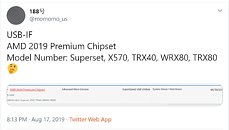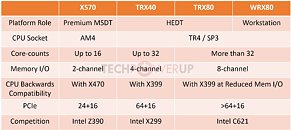Thursday, August 29th 2019

AMD Readies Three HEDT Chipsets: TRX40, TRX80, and WRX80
AMD is preparing to surprise Intel with its 3rd generation Ryzen Threadripper processors derived from the "Rome" MCM (codenamed "Castle Peak" for the client-platform), that features up to 64 CPU cores, a monolithic 8-channel DDR4 memory interface, and 128 PCIe gen 4.0 lanes. For the HEDT platform, AMD could reconfigure the I/O controller die for two distinct sub-platforms within HEDT - one targeting gamers/enthusiasts, and another targeting the demographic that buys Xeon W processors, including the W-3175X. The gamer/enthusiast-targeted processor line could feature a monolithic 4-channel DDR4 memory interface, and 64 PCI-Express gen 4.0 lanes from the processor socket, and additional lanes from the chipset; while the workstation-targeted processor line could essentially be EPYCs, with a wider memory bus width and more platform PCIe lanes; while retaining drop-in backwards-compatibility with AMD X399 (at the cost of physically narrower memory and PCIe I/O).
To support this diverse line of processors, AMD is coming up with not one, but three new chipsets: TRX40, TRX80, and WRX80. The TRX40 could have a lighter I/O feature-set (similar to the X570), and probably 4-channel memory on the motherboards. The TRX80 and WRX80 could leverage the full I/O of the "Rome" MCM, with 8-channel memory and more than 64 PCIe lanes. We're not sure what differentiates the TRX80 and WRX80, but we believe motherboards based on the latter will resemble proper workstation boards in form-factors such as SSI, and be made by enterprise motherboard manufacturers such as TYAN. The chipsets made their way to the USB-IF for certification, and were sniffed out by momomo_us. ASUS is ready with its first motherboards based on the TRX40, the Prime TRX40-Pro, and the ROG Strix TRX40-E Gaming.
Source:
momomo_us (Twitter)
To support this diverse line of processors, AMD is coming up with not one, but three new chipsets: TRX40, TRX80, and WRX80. The TRX40 could have a lighter I/O feature-set (similar to the X570), and probably 4-channel memory on the motherboards. The TRX80 and WRX80 could leverage the full I/O of the "Rome" MCM, with 8-channel memory and more than 64 PCIe lanes. We're not sure what differentiates the TRX80 and WRX80, but we believe motherboards based on the latter will resemble proper workstation boards in form-factors such as SSI, and be made by enterprise motherboard manufacturers such as TYAN. The chipsets made their way to the USB-IF for certification, and were sniffed out by momomo_us. ASUS is ready with its first motherboards based on the TRX40, the Prime TRX40-Pro, and the ROG Strix TRX40-E Gaming.


55 Comments on AMD Readies Three HEDT Chipsets: TRX40, TRX80, and WRX80
But lets be honest i am pretty sure those will be like the xeon boards the best you can get.
However those who game should not even look at these boards at all, they are build to last and often use ECC memory which games really do not like.
The question is will the TRX80 chipset be able to run faster memory or will it again be limited for safety as usual.
Ofcourse i have to add that even though 5000 mhz memory is available its not going to make a great jump in performance like everyone is expecting. I certainly use 3000+ memory but overall the gain is not so high.
The only thing which is not going fast enough for me is drive speed, even though i like nvme its not as fast as for instance the intel pci ssd cards. They excel in synthetic benchmarks but at normal tasks second hand enterprise ssd beat the nvme at its own game. I use many used enterprise ssd because companies constant replace them to prevent data loss might happen. But i promise you those second hand drives can last very long in you pc.
Most of these drives have a super high number of write cycles, let me be straight here they can die ofcourse.
But i use them since intel released the first ssd's those are what about 15 years old or something near.
But they still run perfect " with zero failures up to now" in my nas a read/write cache and i used them alot in raid 0 with 4 or 8 of them to store my games and heavy programs on them and the loaded every virtual machines from and on them ( constant updated also ) so the read and writes are so high i will not even try to copy them over for you to see. And they still running like nothing has been written on them since the first day.
Ofcourse i admit i constant take care of them and keep a good bit free but this far non of them has more than 20 cells locked as unusable yet .... 15 year heavy usage try that with a hard drive.
Anyway lets wait and see how they are going to implement these in reality, but i really consider switching to the trx80 because that would alow me to run much more and hopefully very fast ram memory.
But i admit to wait till people have used them, because i really know how nasty latency can work out.
For insance my main issue is that even though you have 3 nvme slots they almost allways share this pci-e lane with each other or worse even with the gpu slot.
The even worse scenario is what i detected on several motherboards is that when you want to use 2 gpu in your system.
You have on many motherboards that it they switch to 8x + 8x which is kinda no problem unless you use also a nvme expansion card ... which makes all port swicth to x4 ....
But worse is some switch to 8x + 4 x making the second card run pretty darn slow, even without a 3th slot used
Now with each new generation of pci-e we expect that the theoretical speed kinda doubles, but this is also not really true except on paper in reality its a lot less
Then why do some of the people who also are gamers want these boards and actually would sometimes love at trx80 or the wrx80 boards ...
The reason is simple the enormous amount of real available pci-e lanes on these boards to make it possible to really use the slots at full 16X speeds regardless the amount of cards pushed in the slots
I actually have used quad or duo xeon boards from servers because you can get alot working like a charm without the sharing a pci-e lane issues
And often have more than enough extra slots on the boards to make the most demanding users happy that they can use a combination of needed devices without too much stress.
For instance most workstation boards have native biforcation onboard, so super combiantion with plenty of nvme cards with 4 slots filled are no problem and allow you to have loads of possibilities top make use of, so also allowing you to have indeed 3 or 6 different network cards work perfect.
For instance many of my friends have alot of thunderbold 3 devices because their hobby is audio and video related stuff the need for massive and super fast storage is pretty darn high if you work with the highest quality of sound and video and i mean really insane numbers. Some of them even started creating 8K or higher content already.
But there is alot more what can make you desire a high end motherboard.
I actually wanted to make use from TB3 devices for a long time but could not get most of the consumer boards with TB3 work as intended and also wanted a raid0 of 3 nvme disks but besides that i use massive storage on ssd and backup those to my 4x 6 TB harddrives
I ended up to have to buy a exernal NAS because this is impossible to do with a consumer based motherboard even the most expenssive ones fight with each component for instance my current top of the line motherboard will not allow me to use more than one NIC it simply goes berserk especially if i try to use and the 10 Gb nic, 1Gb nic and the ax wifi together it really does not work. you end up with a crashing system even though all 3 networks are absolute 3 separate ones. So my guess is again the sharing pci-e lanes with other devices blocking the usage.
This also blocks my need for more harddrives as well because when you use 2 or 3 nvme ssd your 8 sata ports get disbled well actually the 4 because i found that those also have shared slots or a limit on the maximum used ports. So when you think buy a board with a second sata controle. well guess what i actually have that but again the same freaking problem the pci-e slots are shared so even though its all available you can only choose which one can be used or not and the second problem is that the second sata controller can only address 4 drives thats it.
So my final conclusion is that sharing is not really working EVEN when many people claim this irq sharing is solved ... ITS NOT.
You consant end up having issues that high capacity devices need their own IRQ and need their own PCI-E lane if not they end up in conflict and fighting over the access.
I admit at some things its not so important but when using high speed devices and getting 1/4 or less the speed you feel pretty betrayed with such super expenssive and fast devices.
Not even mentioning the price you payed for a super gamer motherboard which actually does not give what you payed for it.
But as the much cheaper ones only allows some of the build in options to actually work, but almost never together.Actually they already just released the first AMD based models which i already knew would come.
Its no longer intel alone, it will be now a mix intel and amd from now on.
Even though it will take a while to see more models also sporting AMD cpu's i am pretty sure it will happen if AMD also creates power effecient with lesser cores workstation cpus
Because now its still power efficient xeon models what they use, because it does not need to be much more in many NAS devices
I really can not think what a 24 core cpu would need todo on a NAS with most of its cores ;), even if you have a small/medium business its simply overkill
Only very small business take the risk to have everything running on one single device. When growing they rapidly need more cpu power than most nas can provide.
Because the bigger and faster NAS are often not cheap either so growing company most of the time choose to place a cheaper server instead of having everything on one device.
And to be honest i have worked with companies who really used their NAS devices to darn well that they where pretty busy doing just that what they needed todo.
Adding more tasks would cripple the performance for the high need of providing images and restoring the client machines to the original state ( high security environments)
I just realized this thread is from 2019.